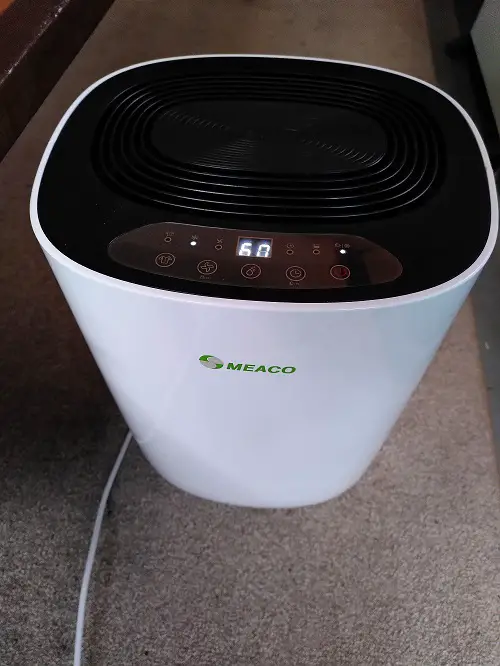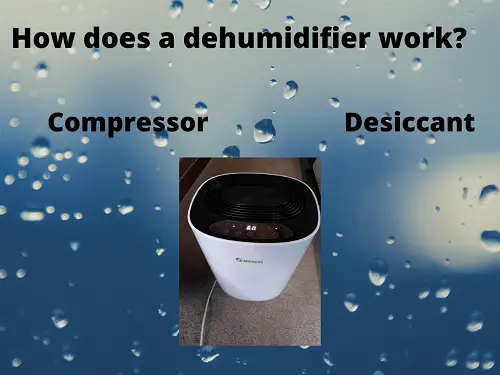Dehumidifiers cause water vapor to condense using a refrigerant (compressor dehumidifier) or absorb water vapor with a desiccant (desiccant dehumidifier). The water is collected in a container so you can dispose of it.
Dehumidifiers lower the relative humidity level of the air. There are two types of dehumidifiers which both use a different mechanism for the same purpose of removing water vapor from the air. They work differently and are used at different temperatures and humidity levels.
Here is a step-by-step explanation of the general process:
- a fan runs the air through the dehumidifier (powered by the compressor)
- it either uses a refrigerant to cause condensation (compressor-type), or
- a desiccant for absorption of water vapor (desiccant-type)
- the water is collected in a container
- the dried air comes out the other side of the dehumidifier
- the container can be emptied to expose of the water
How does a compressor dehumidifier work?
A compressor dehumidifier uses a fan to run the air along coils cooled similarly to a fridge. As the air cools, the water vapor in the air starts to form condensation. This water is collected in a container so you can dispose of it. Then, the dried air is blown back into the room.
Here’s a step-by-step explanation of how a compressor dehumidifier works:
- A fan sucks in humid air (powered by the compressor)
- The air is run along coils that are cooled similarly to a fridge
- Because the air cools down, it cannot hold all its water vapor. This causes condensation, removing moisture from the air
- The condensation is collected in a container
- The dried air comes out the other side of the dehumidifier
- By emptying the container, you can dispose of the water
Compressor-type dehumidifiers are the most commonly used household dehumidifiers.
- Depending on their capacity, they can use between 20 and 500 watts
- They produce noise of about 38 to 65 decibels
- They perform optimally at 60 to 95 °F (15 to 35 °C), and
- Work best at conditions of 65% relative humidity and higher
- Their efficiency decreases with decreasing humidity levels

How temperature and humidity affect compressor dehumidification
Compressor dehumidifiers work best at relatively high temperatures of 68 °F (20 °C) and higher. They also work best at relatively high humidity levels of 60% RH and higher. When either the temperature or the relative humidity drops, the efficiency of the device drops.
How temperature affects the dehumidifier
Compressor dehumidifiers can work between 41 and 90 °F (5C and 30 °C). However, they are less efficient at the lower end of this temperature scale. When the temperature difference is large, condensation occurs more quickly. For example, a cold drink on a hot day results in condensation on the outside of the glass. Or, on a cold day, when the room is warm, condensation starts to form on the windows.
When the temperature difference between the air and the coils is less, less condensation will form. Making the device less efficient.
Below 41 °F (5 °C), the internal coils can start to form frost. Frost makes the device stop functioning and can cause damage to its parts. Therefore, some models have an anti-freezing feature that switches off and on continually as necessary. However, in anti-freezing mode, they are not dehumidifying the air.
How humidity affects the dehumidifier
Compressor dehumidifiers perform less efficiently at lower humidity levels. Low humidity means the air can contain more water than it currently does. For example, 50% humidity means only 50% of the air is saturated. However, water vapor only leads to condensation when the air has reached full saturation (100% relative humidity). Therefore, the air needs to cool down a lot, or humidity levels need to be higher.
Since the air needs to cool down so much, and the internal coils cannot drop too low before freezing, dehumidification is less efficient at low humidity levels.

How does a desiccant dehumidifier work?
Desiccant dehumidifiers use a fan to run air along a rotating wheel that contains a desiccant (a water-absorbing substance). Internally heated air is run along the other side of the wheel, taking up the water from the desiccant. This warm, humidified air is run along cold coils, causing condensation. Then, the water is collected in a container so you can dispose of it.
Here’s a step-by-step explanation of how a desiccant dehumidifier works:
- Your indoor air is sucked into the device by a fan
- This air runs along a spinning wheel that contains a desiccant
- The desiccant absorbs water vapor from your air like a sponge, and continuous to spin
- Your air is dried, and comes out the other side of the device
- Another fan sucks in another bit of air
- This air is heated and run along the other end of the wheel in the opposite direction
- This heated air takes up water from the wheel (because hot air can contain more moisture)
- The hot humid air runs along coils the temperature of the incoming air, and is therefore cooled
- Because the hot humid air cooles down, condensation occurs on the coils
- This condensation is collected in a container
- The warm air comes out the other side of the dehumidifier
- You can empty the container once its full to dispose of the water
The following video on youtube explains the workings of a desiccant dehumidifier quite well. However, the type of desiccant dehumidifier used in this example is an industrial dehumidifier that simply loses the warm humid air to the outside air. As mentioned above, houshold desiccant dehumidifiers collect the moisture and reintroduce the warm air indoors.
Desiccant dehumidifiers are more common in industrial settings, although they are becoming available for households as well. They still work very well at low temperatures and low humidity levels.
A dehumidifier for use in a room about the size of an average american living room (330 sq. ft.) will approximately have the following specification:
- They can use between 300 and 700 watts
- They produce noise of about 32 to 45 decibels
- They perform regardless of temperature, and
- can still remove water vaport when humidity levels are very low
How temperature and humidity affect desiccant dehumidification
A desiccant dehumidifier is not affected by the temperature of the air. The desiccant acts as a sponge, absorbing water vaport from the air. It does this regardless of the temperature.
Humidity levels slightly influence the absorption capacity of the desiccant. Low humidity levels means that the moisture difference between the air and the desiccant is smaller. Therefore, the process is a little slower.
If you are considering purchasing a dehumidifier, I recommend reading my helpful guide first:



